Lepcis Magna: Romanization
Q191504Lepcis Magna: Phoenician colony, later part of the Carthaginian empire, the kingdom of Massinissa, and the Roman empire. Its most famous son was the emperor Septimius Severus (r.193-211).
Civil wars
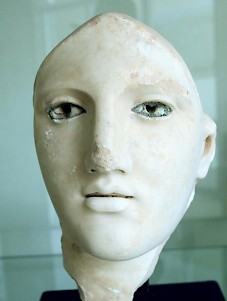
By the end of the second century BCE, Lepcis had become part of the Roman world. Italian merchants and bankers visited the city, and when Lepcis had a quarrel with the Numidian leader Juba, it asked and received support from the Senate.note However, Lepcis did not only look to the north. We know that there were trade contacts with Alexandria in the east and an inscription from Arsinoe mentions grain imports from Lepcis.
That the city was rich, can also be deduced from the fact that it could afford to pay a fine of no less than three million pounds of olive oil per year after it had supported the enemies of Julius Caesar during the Second Civil War.note It has been estimated that the city must have owned at least one million olive trees to pay this fine.
Augustus
To a commercial town like Lepcis, the end of the civil wars brought many benefits, and the new ruler of the Roman world, the emperor Augustus, realized that the advantages were mutual. Prosperous provinces could pay more tribute, and to make sure that this happened, the defenses of Africa were improved. The Third Legion Augusta was sent out to protect Africa. The precise circumstances of its deployment are not recorded, but it is certain that it was in Africa in 30 BCE, probably at Theveste.
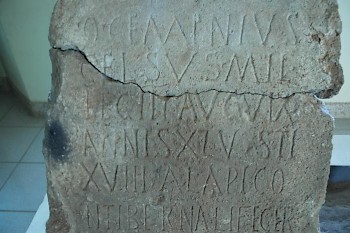
The area had not yet been fully pacified, though. It is no coincidence that the poet Virgil calls Africa terra triumphis dives, "a country rich in triumphs".note Triumphal entries are recorded in 46, 34, 28, 21, and in 19, when Lucius Cornelius Balbus reached the Fezzan and defeated the tribe of the Garamantes, who adapted a more settled life style. Their towns became an important trade center, connecting Subsaharan Africa with the Mediterranean, where Lepcis was the next node in the commercial network.
Still, this was not the end of the war: several more desert campaigns took place during the reign of Augustus - one of them led by the Quirinius who is better known from the Christmas story - until Cornelius Cossus Lentulus established some sort of peace after defeating the Gaetulians.note To facilitate troop movements, roads were built, like the one between Lepcis and Oea.
Officially, the city had the rank of civitas libera et immunis, which meant that it was supposed to be free and did not have to pay taxes. Its independence was to some extent real: Lepcis continued to have its own suffetes and minted its own coins. Fscal freedom, however, was another matter. As long as the city had to send three million pounds of olive oil, it was de facto a tax paying town. The Italian Perperna and the Fulvii who are known to have lived in Lepcis during the reign of Augustusnote may have been tax collectors by another name. They must have been the inhabitants of the Italian-style atrium houses that have been identified (e.g, the Villa Selene).
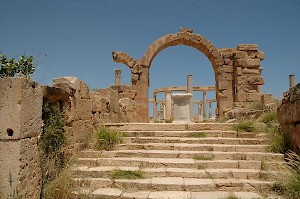
New stone quarries were opened and several new buildings were erected. One of them was the macellum or market, which was, according to the inscription paid for by a man who calls himself Annobal Tapapius Rufus, combining Punic and Roman names, and latinizing his family name, Tabahpi.note The Tapapii would become important benefactors, but were by no means to only ones. We know of a Yatonbal who was nicknamed "the Builder" (more...). However, the Tapapii were the greatest builders. The same Annobal Tapapius Rufus paid for the theater, which was finished in 1-2 CE.note
Nor was this the end of this phase of urban renewal. During the last years of Augustus' reign, the Chalcidicum was built. The old Punic market was paved,note retaining the ancient trapezoidal shape, and a new temple was added to the existing pair. One of these was dedicated to Shadrapa (now sometimes called Dionysius); the other one was probably built for Melk'ashtart ("Hercules"), but had been rededicated to Augustus and Roma. Every year, two citizens officiated as flamines Augusti, "priests". The third, new temple may have been a replacement for Melk'ashtart.
Tiberius
The reign of the emperor Tiberius (r.14-37) witnessed the insurrection of Tacfarinas. This Numidian leader revolted in 17 and gained support from peasants and nomads who felt threatened by the expansion of the cities of Tripolitana. Together, they created much havoc along Rome's desert frontier. The Third legion Augusta found it hard to destroy the rebels, and needed to be reinforced by VIIII Hispana, which was commanded by a Publius Cornelius Scipio, who was honored by the Lepcitanians with a small monument.note Even with these additional forces, the Romans were almost unable to overcome Tacfarinas, who remained at large until 24.
Again, roads had to be build to redeploy troops, like the one that connected Lepcis to a sanctuary of Ammon, 66 km in the interior (more...). Unfortunately, this military measure, although useful in the short run, aggravated the problems, because the roads helped to develop new agricultural zones: land that had been too far from the urban market and had been used as pasture for goats and dromedaries, was now converted into arable land, and the products could be sold in the cities. As a corollary, the nomads had less space, which increased their misery. However, for the time being, they remained quiet.
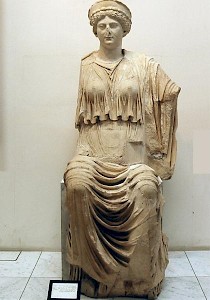
The Lepcitanians expressed their gratitude to Rome by setting up a statue for a commander named Gaius Gavius Macer, expanding the temple of Augustus and Rome,note dedicating a monument to Augusta Salutaris, and erecting an honorific Arch of Tiberius. This commemorated the paving of several streets (a sign that the city was exanding), and was financed from the proceeds of land in the interior that had been confiscated from native tribes after the revolt of Tacfarinas. This happened during the governorship of Gaius Rubellius Blandus, by marriage a grandson of the emperor, and also responsible for dedicating a temple to Ceres Augusta in the theater, which had been paid for by Suphunibal, daughter of the already mentioned Annobal Tapapius Rufus who had built the theater itself. In 43, another member of the Tapapius family, Iddibal son of Mago, paid for a shrine to the "Di Augusti", i.e., Augustus and his wife Livia.
Claudius and Nero
Until now, the romanization of Lepcis had consisted of erecting new buildings, dedicating monuments to Roman grandees, paying taxes, accepting mixed names, and doing business with Italians merchants and bankers. From the reign of Claudius (r.41-54) on, things started to change, because he allowed many people to become Roman citizens. Many Lepcitanians were enfranchised through a governor named Quintus Marcius Barea, and henceforth called themselves Marcius. (The Libyan clan that was to build the Northern Cemetery of Ghirza was enfranchised by a descendant of this first generation of Marcii.) Other Lepcitanians had other benefactors. A philosopher named Lucius Annaeus Cornutus, the teacher of the poet Lucan, appears to have owed his Roman citizenship to Seneca, one of the advisers of the emperor Nero (r.54-68).
Not every wealthy family received the citizenship, as is shown by the names on the inscriptions. According to IRT 338, in 53/54, a mannamed Gaius ben Anno, brother of a suffete, paid for a new colonnaded portico that surrounded the Old Forum, to honor his grandson Gaius Phelyssam. The work was completed by another grandson, Ba'alyaton Commodus ben Macer. The city's council, which was by now calling itself senatus, erected a statue for the same grandson, who must have been a special boy.
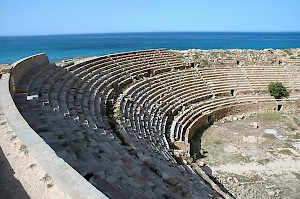
Three years later, the Lepcitanians received their own amphitheater, which had been excavated in a former quarryeast of the city, close to the sea. To deduce from the inscription,note there were no wealthy citizens involved in this building project, so it may have been a project undertaken by the council.
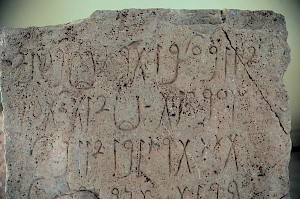
The next big project, however, did have a sponsor: Ithymbal Sabinus, son of Arish and a member of the Tapapius family, gave Lepcis a portico along its harbor.note Not far from this place, along the road that was later redecorated by the emperor Septimius Severus and has been called Colonnaded Street by the excavators, erected an honorific inscription for his "aunt Arisuth, the daughter of Yatonbal the Builder, in honorable memory of a beneficient deed". It is one of the latest inscriptions written in Punic.
Civil War
Since Caesar had fined the city, a century had passed. Lepcis had expanded and had become part of the Roman world. Like the other cities of Africa, it was wealthy, and this was to have grave consequences. Early in 68, several men revolted against the emperor Nero: Gaius Julius Vindex in Gaul, Servius Sulpicius Galba in Spain, and Lucius Clodius Macer in Africa. The last-mentioned built a new legion, I Macriana Liberatrix, and may have hoped to become the new emperor. After all, he could use the wealth of Africa. However, after the suicide of Nero, Galba was the new ruler of the Mediterranean world, and Macer was assassinated.
Almost immediately, things went wrong. As the Roman historian Tacitus tells us, the inhabitants of Oea, who were envious of Lepcis' wealth, realized that there was no longer a governor who could act decisively, especially since Macer's successor, Valerius Festus, was a relative of Aulus Vitellius, who had revolted against Galba but was attacked by another contender, Titus Flavius Vespasianus. Valerius Festuscould not employ his troops, which his relative might need, and the Oeans therefore decided to strike at Lepcis, eager to obtain plunder. To make certain that they would be successful, they allied themselves to the Garamantes, who, as we have seen above, had reasons of their own to hate the Lepcitanians.
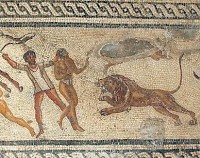
The attackers came close to victory, but in the end, Festus did what he had to do: he supported Lepcis, and marched through the desert, to strike the Garamantes at home.note The Lepcitanians got hold of some of the native warriors, and executed them in their amphitheater, an incident shown on a mosaic in the Villa of Dar Buc Ammera.
Literature
- A.R. Birley, Septimius Severus. The African Emperor (1999³ London)
- Oriana Dal Bosco & Maria Teresa Grassi, Libia mediterranea e romana (20054; Firenze)
- Antonino Di Vita e.a., La Libye antique. Cités perdues de l'empire romain (1998 Paris)
- K.D. Matthews, Cities in the Sand (1957 Philadelphia)
- D.J. Mattingly, Tripolitania (1995)